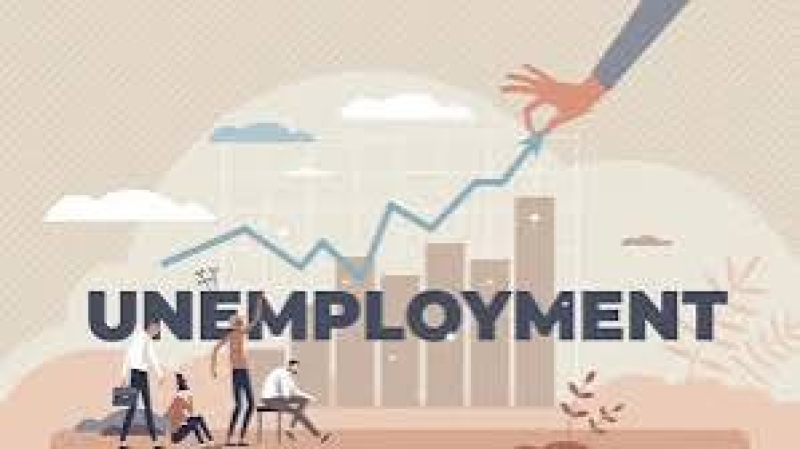- Bangladesh Bank Buys $115 Million to Support Forex Market |
- Tarique Rahman, Daughter Zaima Added to Voter List |
- NCP and LDP Join Jamaat-Led Eight-Party Alliance |
- Tarique Rahman’s gratitude to people for welcoming him on his return |
- Attorney General Md Asaduzzaman resigns to contest election |
Why unemployment is increasing

The Bangladesh Bureau of Statistics (BBS) has revealed a concerning rise in unemployment rates across Bangladesh. According to their data, during the first quarter of 2024, the unemployment rate in the country surged by 3.51% compared to the last quarter of 2023.
With the latest development, there are approximately 240,000 new unemployed individuals, with the current tally standing at 2.59 million, up from 2.35 million in the preceding quarter.
According to International Labor Organization (ILO) standards, individuals who have been actively seeking employment for the past 30 days but have not secured work for at least an hour in the last seven days are classified as unemployed.
The latest labor force survey, released on May 6, shows a notable increase in unemployment across both male and female demographics during this period, reports DT.
However, despite the overall unemployment rate remaining stable compared to the same quarter last year, there has been a divergence in male and female unemployment trends, with the former on the rise and the latter witnessing a slight decline.
Experts note that if investment in the public and private sectors decreases, employment opportunities are lost. And if employment opportunities decrease, unemployment increases.
According to economists, rising fuel prices, as well as the dollar crisis, are major obstacles to private sector investment. New investments are hindered in the private sector due to several challenges in securing bank loans easily.
Although public sector investment is on the rise, government-funded projects often fail to generate significant employment opportunities.
To address this pressing issue, economists suggested initiatives to bolster self-employment opportunities.
According to experts, if there is no alternative policy to reduce unemployment or no demand in the labor market, then there is no reason to increase employment.
As a result, unemployment will continue to rise. To solve the unemployment problem, the educated unemployed should be made self-reliant through technical training. They should be given the opportunity to become entrepreneurs by giving loans on easy terms without interest.
According to BBS statistics, at least two million people enter the job market every year. Around 1.3-1.4 million of them are employed within the country. The rest goes abroad. The number of unemployed has been between 2.4-2.8 million for the last two decades.
What surveys say?
The World Bank's latest Macro Poverty Outlook for Bangladesh report released on April 2 has predicted that between 2022-23 and 2023-24 fiscal year, about 500,000 Bangladeshis will again slide into extreme poverty. It means their daily income will be less than $2.15.
The World Bank report also said that the inflation rate will reach 9.6%. The high inflation has also become the driving force behind the alarming trend of rising unemployment.
According to the private research firm South Asian Network on Economic Modeling (Sanem), the number of unemployed fluctuates due to seasonal changes. Due to this, the unemployment rate may increase in the first quarter of this year compared to the last quarter of last year.
For example, in the agricultural sector, the rate of labor increases or decreases in each season. As a result, the unemployment rate has increased in the first quarter of this year compared to the fourth quarter of last year due to natural causes.
The private think-tank said that there is no possibility of increasing employment if demand does not increase.
Meanwhile, a survey conducted by the research organization Bangladesh Institute of Development Studies (BIDS) in the last quarter of 2021 revealed that 66% of the graduates from national universities are unemployed.
What experts say
Fahim Masroor, chief executive of BDjobs, said that the number of educated unemployed is increasing mainly due to three reasons.
The main reason is the large mismatch between demand and supply in the job market, he said.
Fahim Masroor pointed out that the second reason is the country currently has increasing job opportunities in the manufacturing and agricultural sectors. In these two sectors, there are less job opportunities for graduates and the demand for technically skilled people is high. The educated youth who are in the job market, they do not want to involve themselves in these jobs.
Thirdly, business has been greatly affected due to the Covid-19 pandemic. As a result, the educated demographic who were involved in self-employment through small businesses, have also become unemployed at that time.
Calling for giving importance to market-based education, he said that there is a demand for technical education in the job market. People need to be encouraged to learn the trades.
Fahmida Khatun, executive director of Centre for Policy Dialogue (CPD), a private research institute, said opportunities should be created for educated youth to be interested in creating employment on their own initiative.
"To foster entrepreneurship, individuals require access to bank loans, which currently remains a challenge. Our financing system lacks the necessary impetus to facilitate this. Given the current scenario, prospects for increased private sector investment are bleak. Thus, it's imperative for youth to pursue self-employment avenues by enhancing credit facilities," she emphasized.
What govt says?
State Minister for Finance Waseqa Ayesha Khan expressed optimism about the country's economic trajectory, citing improvements in inflation, exchange rates, and law and order.
“In a word, the country’s situation is now investment-friendly. If investment increases, employment will surge as well. I hope that the unemployment rate will decrease very soon,” she said.

